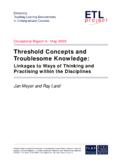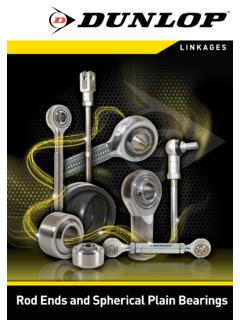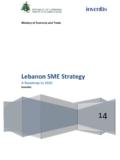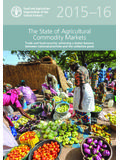Transcription of Development of Carbon Fibre Suspension Linkages for ...
1 IOSR Journal of Mechanical and Civil Engineering (IOSR-JMCE) e-ISSN: 2278-1684,p-ISSN: 2320-334X, Volume 14, Issue 4 Ver. V (Jul. - Aug. 2017), PP 38-44 DOI: 38 | Page Development of Carbon Fibre Suspension Linkages for Formula Sae Vehicles *Devendran Thirunavukarasu 1, Alan John Maniamkot 2, Noorul Hug R1, Ashok Kumar M1, Dinesh Kumar D1 1(ST Advanced Composites (P) Ltd, Chennai 60087, Tamil Nadu, India) 2(Department of Mechanical Engineering, IIT Bombay, Powai, Mumbai 470006, Maharashtra, India) Corresponding Author: * Devendran Thirunavukarasu Abstract: Reducing weight while maintaining structural integrity is one of the key challenges of Formula SAE teams, during the design of Suspension of the formula car.
2 The purpose of this paper is to present experimental data on designing and optimizing a Carbon Fibre Suspension system for formula cars. The reason Carbon Fibre suspensions are favoured over the current steel suspensions are because they can reduce the weight of the Suspension system by 75 %. Pull tests on a universal testing machine were performed on two different specimens made of Carbon Fibre tubes with different inserts bonded on each tube mild steel and aluminium insert. Pull tests were carried out to test the strength of the adhesive bond between the aluminium and mild steel inserts with the Carbon Fibre rod. Aluminium insert adhesive bond failed at kN and the Mild Steel insert adhesive bond failed at kN.
3 Both of them are much higher than the maximum force the rods will experience. Keywords: Suspension , A-arm, Carbon Fibre Reinforced Plastics, Adhesive, Formula Student/Formula SAE competition ---------------------------------------- ---------------------------------------- ---------------------------------------- --------------- Date of Submission: 12 -07-2017 Date of acceptance: 10-08-2017 ---------------------------------------- ---------------------------------------- ---------------------------------------- --------------- I. Introduction The Suspension system of a race car transfers the forces acting on the tyres to the chassis of the car.
4 A basic level Suspension system is a system of Linkages which limits the degree of freedom of a wheel with respect to the car. Most of the race cars use a wishbone type Suspension system. Each car will have a different geometry of Suspension Linkages depending upon the requirements. But at a basic level, each Suspension geometry can be defined as a series of binary Linkages which are interconnected. These Linkages transfer enormous amounts of forces during certain worse case scenarios. Thus, it has to be strong enough to withstand it. Traditionally MS rods were used to manufacture it due to its strength and reliability. II. Carbon Fibre Suspension Linkages 3D model of the CFRP Suspension Linkages are shown in Sprung mass vs unsprung mass In a racing car it is always a priority to reduce the weight of the car for better acceleration but it is even more advantageous to reduce the unsrpung weight of the car or in other words the parts which are always moving with respect to the body of the car.
5 Suspension Linkages form an unsprung mass and make it lighter for better performance. Thus it was decided to use any non conventional technique to create lightweight and reliable Suspension arms. Design constraints The main function of CF rods is to take the compressive and tensile forces from the upright of the car and transfer it to the chassis. All the rods can be approximated as 2-force members and these Linkages must be strong to withstand compressive and tensile loads of 7,000 N. The outer diameter of the rod should be kept low (<18 mm) so that the rods won t interfere with other components when they move. It should be detachable from the other components of the car.
6 Due to manufacturing errors in other parts of the car there should be a method to vary the length of the rod by small amounts for perfect assembling. Keeping in mind the various design constraints, the following design was innovated and implemented. The various components of the design are as follows A-arm end Mild steel inserts Aluminium inserts Adhesive Development Of Carbon Fibre Suspension Linkages For Formula Sae Vehicles DOI: 39 | Page Carbon Fibre rod Threaded insert 3D model of the CFRP Suspension Linkages A arm end A-arm end ( ) is an integral part of the Suspension geometry which connects the Suspension Linkages to the upright and hub.
7 To implement Carbon Fibre Linkages the design of A-arm ends has to be modified from the conventional design. It was decided to make A-arm ends out of aluminium 6061. It was not possible to directly join the Carbon Fibre rods and the A-arm end because it might be manufactured again in case the rods didn t align exactly with the chassis of the car due to manufacturing errors. Also it was advantageous to have a small control over the length of the Linkages to tune the vehicle dynamics parameters. Hence it was decided to join the A - arm end and the Carbon Fibre rods using threading. By loosening or tightening the threads it is possible to adjust the length of the rods.
8 A arm end External thread insert An external thread will be constructed on the two protrusions seen in the and the links are attached through these threads. Due to the huge forces acting on the A - arm end the minimum outer diameter of the protrusions were found to be 6 mm. Mild steel inserts The threaded insert is put on the protrusions of the A-arm end. This is necessary because it is not advised to directly attach the external threads on the A-arm end made of aluminium with another thread due to the inherent weakness of aluminium threads.
9 Inner diameter of the thread insert is 6 mm and the minimum outer diameter available is 10 mm. The strength of the adhesive bond which holds the Mild Steel insert and the CF rod together is very sensitive due to the following factors The total adhesive surface area Nature of the insert material and the CF rod Surface treatments Development Of Carbon Fibre Suspension Linkages For Formula Sae Vehicles DOI: 40 | Page Thus the length of the insert was decided so that adhesive sufficient surface area is available. A small step was provided at the bottom of the insert to block the adhesives from flowing away during the manufacturing.
10 Careful attention was given to ensure that the bond length of the adhesive remained uniform and ideal. A bond length of .004 - was found to be the ideal bond length. Thus .008 inches was approximately equal to mm was chosen to be the bond length. Due to the weak nature of threads in Aluminium A - arm end an extra thread insert was put between the MS insert and the A - arm end. The minimum outer diameter of the thread in A - arm end is 6 mm. A thread insert of thickness 2 mm was put over it. Another MS insert of thickness mm was put over the thread insert. The thickness of the adhesive or the bond length is ideally mm. Hence the total outer diameter became 14 mm.
















